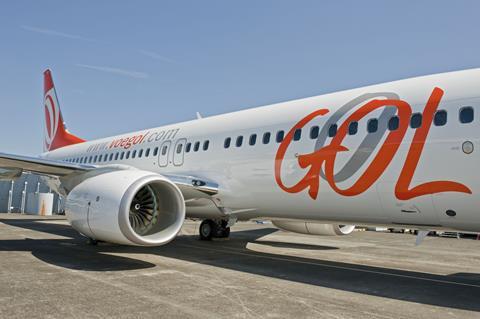Brazil’s Gol reports higher revenue for the final quarter of 2021 as it continues its fleet transformation and keeps costs in check, while at the same time keeping an eye on possible market consolidation.
“In 2021… we made significant progress across multiple measures of success, derived from our winning business model, a highly flexible and efficient fleet, and by providing a customer experience that continues to build preference for our brand,” Gol chief executive Paulo Kakinoff says on 14 March. He spoke during the airline’s quarterly earnings call.
Gol achieved R$2.9 billion ($570 million) in revenue for the final quarter of the year, up from R$1.9 billion in the same quarter one year earlier.
For the full year, the carrier’s revenue rose 16.7% to R$7.4 billion, up from R$6.4 billion in 2020.

The company posted a R$682 million loss for the quarter, compared to R$862 million during the same quarter in 2020. The company’s full-year loss was R$3.6 billion.
The Sao Paulo-based carrier is “fully committed to judiciously expanding its operations to meet the growing demand for air travel, while also controlling costs and achieving operational efficiencies”.
In the fourth quarter, Gol transported 6.5 million customers, up 26.1% compared to the fourth quarter in 2020, and about 67.9% of the same quarter of 2019.
“For 2022, we’ll maintain focus on the fleet transformation to the 737 Max,” Kakinoff says. “We expect that by year’s end we will have 44 aircraft of this model in service, which will represent around 30% of the total fleet.”
At the end of 2021, the all-Boeing 737 operator 135 aircraft, including 23 737 Max. GOL also held 102 firm orders for Max, including 80 for Max 8s and 22 for Max 10s.
“Accelerating our fleet transformation positions us more competitively for growth through greater flexibility in our capacity management and enables the expansion of routes and destinations, which will ensure we are highly efficient at meeting fluctuations in travel demand,” says Celso Ferrer, the company’s vice-president of operations.
Gol expects to reinstate flights to the USA in May, Kakinoff says, as it “carefully” ramps up operations following a two-year pause.
The company also sees corporate travel returning in the coming months, and it plans for higher ticket prices as that segment returns.
“After carnival we saw a strong catch-up on corporate demand, not yet close to pre-pandemic levels, but accelerating,” says Kakinoff. As coronavirus protocols are relaxed, Gol expects more business travellers, and therefore rising yields on ticket sales.
“There will be a crowding out of the lower-yielding passenger in favour of the higher-yielding passenger,” says chief financial officer Richard Lark. By June or July, the airline should return to a “normalised” passenger mix of 70% corporate travellers, with the balance being leisure travellers, he adds.
M&A ACTIVITY
Kakinoff also foresees “interesting” merger and acquisitions opportunities in the region as airlines adjust to the post-pandemic new normal. The company already has 14 codeshare partners and 38 inter-line agreements, but more partnerships could be in the offing.
“In the post-Covid environment, we believe the landscape will shift in the region,” says Kakinoff. “It may be time to reconsider whether the code share and interline approach goes deep enough to capture the available synergies for expanding the network.”
“There’s no reason to believe that a global trend for the airlines will not happen here [in South America],” Kakinoff says. “We have prepared ourselves to play a major role in that trend if it happens.”
Last year, the company acquired Brazilian domestic regional airline MAP Linhas Aereas, which operates to the Amazon region via a hub in Manaus. That transaction was approved by Brazilian antitrust authorities in December.


























